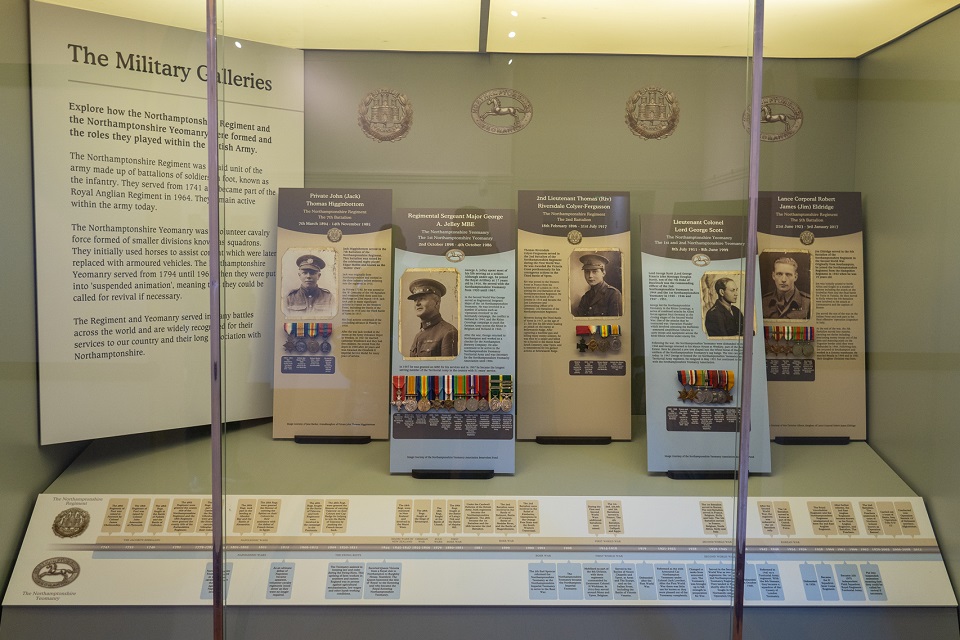Northamptonshire Yeomanry

Northamptonshire Yeomanry timeline

Find out about the exploits of the Northamptonshire Yeomanry from their formation in 1794.
The Northamptonshire Yeomanry timeline
A state of suspended animation
The Northamptonshire Yeomanry were placed into ‘suspended animation’ meaning that they could be called for revival by the government if needed.
Part of the Territorial Army
The Northamptonshire Yeomanry became part of the 250 (Northants Yeomanry) Independent Field Squadron, Royal Engineers Territorial Army.
Inter Corps Regiment
The Yeomanry were absorbed into the D Squadron Inter Corps Regiment.
The Yeomanry are disbanded
Once again, the Yeomanry are disbanded as part of an Army reorganisation.
Reformed as part of the County of London Yeomanry
Reformed in 1947 as a Territorial Army Regiment and with the 8th Hussars they became a squadron of the London Yeomanry.
Disbanded after the Second World War
After service in the Second World War they were disbanded.
Second World War service
The Yeomanry served in the Second World War as two tank regiments, the 1st and 2nd Northamptonshire Yeomanry Regiments. They landed in France shortly after D Day and fought in the Normandy campaign ‘Operation Overlord’.
Tanks replace armoured vehicles
The Yeomanry replaced their armoured vehicles with new tanks. The Yeomanry was brought up to full strength in preparation for war.
Between the world wars
The Yeomanry were reformed as the 25th Armoured Car Northampton Yeomanry under Colonel Jack Lowther. After the First World War there was little use for horses so they were phased out of the Yeomanry completely.
The end of the First World War
The Yeomanry were disbanded after the First World War as they were no longer required.
Service in the First World War
During the First World War they served in 1914 around Mons and Ypres in Belgium. Later in the war they served in the Battle of Neuve Chapelle, at Arras. They fought at Scarpe and on the Italian Front, including the Battle of Vittorio Venetto.
Mobilisation for war
The Yeomanry were mobilised as part of the 8th Division with three regiments commanded by Lieutenant Colonel H Wickham at the start of the First World War. In 1914 they served around Mons and Ypres in Belgium.
Imperial Yeomanry
The Northamptonshire Yeomanry become the Imperial Yeomanry.
Second Boer War
The 5th Earl Spencer reformed the Northamptonshire Yeomanry as the Northamptonshire Imperial Yeomanry to serve in the Second Boer War in what is now South Africa.
A royal visit
They escorted Queen Victoria from a visit to Northampton to Burghley House, Stamford. The Queen bestowed the title ‘Royal’ to the Kettering unit who became the Royal Kettering Northamptonshire Yeomanry.
The Swing Riots
The Yeomanry assisted in keeping law and order during The Swing Riots. This uprising of farm workers in southern and eastern England was a protest against agricultural mechanisation, low wages and other harsh working conditions.
Peace
As the defeat of Napoleon became apparent the volunteer cavalry regiment ‘stood down’ as they were no longer required.
Protecting the country
The Northamptonshire Yeomanry formed as a volunteer cavalry to protect the country against the Napoleonic invasion.
Northampton Museum and Art Gallery military collection
The military collection holds material relating to the Northamptonshire Regiment and the Northamptonshire Yeomanry covering the period 1741-1971. The Northamptonshire Yeomanry collection consists of both objects and documentary archives.

